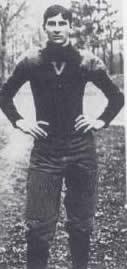Dec. 5, 2007
![]() Stone’s Famous 1907 Catch | History Corner Archive
Stone’s Famous 1907 Catch | History Corner Archive
 |
|
Just over one hundred years ago a play that occurred on Dudley Field was talked about for decades. The play involved Commodore player James “Stein” Stone on November 23, 1907.
Stone began his football career at Franklin’s Battle Ground Academy. After his graduation from the prep school in 1902, Stone continued his playing days at Vanderbilt (1904-07).
While at Vanderbilt, he earned All-Southern and All-American honors in football while also competing in basketball and becoming captain of the track team. Stone also wanted to move from his center position where his chances were greater at scoring a touchdown. He was too valuable as a center that Coach Dan McGugin would not consider such a change.
But, there was one game and one play in which made a legend out of the lineman. Many years later, Grantland Rice once wrote an article for American Magazine entitled, “My Greatest Thrill in Twenty-two Years of Sports.”
The article concerned a play in which Stone executed in the 1907 game against rival Sewanee. Rice witnessed the Thanksgiving Day game on Dudley Field as a writer for The Tennessean. He believed the play to be the greatest he ever saw. Rice wrote in part from the article in American Magazine:
“In one of his earlier games at Vanderbilt, Stone had been sent against Germany Schultz, of Michigan, then treated as the greatest center of the generation. Stone entered this contest with a badly burned ankle that brought him almost unbearable pain at every move. `That man won’t last five minutes,’ said Keene Fitzpatrick, then Michigan’s noted trainer.
“But Stone not only lasted five minutes, he lasted the entire game, and he gave the famous Schultz one of the hardest battles the Wolverine start had ever known. Any chance that Stone might have had to be shifted to a position back of the line was lost forever after that brilliant exhibition.
“The season wore on, but never did Stone realize his ambitious to score a touchdown. His was always the unspectacular work in the line–the work that his mates and opponents could appreciate, but the spectators seldom see. For it is notorious that in football the cheers are for the men who run the ball, and centers rarely get that chance.”
The 1907 Sewanee game would be the last for Stone, as his eligibility would expire. Sewanee was always a tough game on the mountain or off. Vanderbilt entered the game 4-1-1 with wins over Kentucky State, Rose Polytechnic, Mississippi and Georgia Tech. The only blemished was a loss to a powerful Michigan team in Nashville and a tie with Navy at Annapolis.
Rice continued his story in American Magazine with Vanderbilt trailing Sewanee 12-10 late in the fourth quarter. Stone’s terrific play that impressed the legendary sports writer is recalled from memory:
“Then a strange play happened, something out of the ordinary football maneuver. The signal was given, and Stone remained at his position near the right of the field, ready to pass the ball. The remainder of the Vanderbilt team began to scatter out across the gridiron, each man five yards from his nearest comrade.
“The quarterback, one halfback, and one end were the only three who fell back of the open line. Stone had to make a pass of fifteen yards in oblique direction. He had to do this, and then linger for a second and act as if he had nothing to do in the play. He made a perfect pass, held himself admirably, and then like a flash he was off for the goal line forty yards in front of him. He ran as he had never run before, while his teammates were executing a double pass–the ball going from Stone to a player fifteen yards from him, and then to Blake, far over on the other side of the field.
“From this position Blake shot a long diagonal forward pass high onto the air, and aimed for the point toward which Stone was racing. The crowd held its breath; Sewanee players, recovering quickly from their surprise, started charging from all directions upon the great Vanderbilt center, who was now nearing the coveted goal line.
“At the close of his career, Stone had drawn his chance to score a touchdown he longed to score, and it would be the touchdown that brought his team a championship. But apparently Sewanee had him blocked without ever having carried the ball over.
“But Stone had not given up yet. He reached the goal line at the very moment the ball was descending to him out of the air. There was a clash of bodies and from the clash, Stone, also a star basketball player, leaped high into the air. Above the mass of players his two big hands grabbed the ball at least nine feet from the ground; then the swirl of bodies came down with a thud as Stone fell across the goal line, clutching the pigskin tightly in his arms.
“It was the one chance to in his career to make a touchdown, to accomplish his dream; it was the one chance of the man who had played great football for his team, despite the fact that he always wanted to play another position. He made good when the opportunity came; he won glory for his team, and he closed his career as a college athlete with the sweet taste of victory, and of a dream long deferred but finally realized.”
Vanderbilt held on for a 17-12 victory. But in researching this story, it appears Rice made a mistake in his recollection. According to newspaper accounts of the game, Stone was involved in that miracle play, but he did not score a touchdown.
This is how Rice wrote about the play that appeared in his Tennessean story reporting on the game:
“The next play was another trail of the same freak and one that was even more successful. The ball was thrown to Bob Blake and he saw Stein Stone far down the field. He threw the ball forty yards to him, and the great center jumped high above the crowd of Sewanee men around him to receive it. The net result of the play was 30 yards and an opportunity at the touchdown that won the game.
“Morton was called and added three to the 30 just gained and then Honus Craig was given the opportunity to make the last touchdown. He did it in the same style that made him an all-southern half for four years and the game was won. Bob Blake kicked the goal and the score was 17-12 for Vanderbilt.”
The Nashville Banner gave their version of the controversial play more clearly with laterals. There would be an unbalanced line with Stone centering the ball from the end of the line:
“The ball was in midfield. The Commodores lined up and all but “Stein” Stone shifted to the left. He centered the ball to Potts, who passed it to Vaughn Blake, the latter tossing it to Bob Blake who heaved it to Stone, a giant most adept at basketball. He jumped in the air to grab the leather, tumbling down on the 5-yard line. In two tries Morton was over for the touchdown, Blake kicked goal and the game was won, 17-12.
So now there are reports of three different men scoring the winning touchdown–Stone, Craig and Morton. Hugh Potts was a quarterback; Honus Craig at halfback, while the Blake’s were ends. This could have been the first “Music City Miracle.”
Prior to the game-winning touchdown run, Sewanee coaches, players and fans loudly protested the play. The play that gained so much excitement and turmoil was so confusing and unexpected that the Nashville Banner tried to explain what precisely happened:
“In regard to this spectacular play it may clear things up a bit to make a few explanations as to the modus operandi. Being a lineman Stone had to be on the end of the line to receive the pass. To this end he was stationed full eight yards to the right of his nearest teammate. Other members of the team, with the exception of Blake brothers were lined up along the scrimmage line, while Vaughn Blake was back of the line and two yards further to the left.
“Bob Blake was in turn still further out, being stationed so far to the left that there was danger of the pass being too close to center when it was hurled down the field to the fast moving and agile Stone. The officials were apprised of the nature of the play and were asked to observe closely its execution. It was by far the most brilliant feature of the game, and decided the contest in favor of McGugin’s men.”
Whoever scored the final touchdown 100 years ago is not important today. It is just another piece of Vanderbilt football history long forgotten, but excited Commodore fans at the time and the memories lasted for many years.
If you have comments or suggestions you can contact Bill Traughber via e-mail WLTraughber@aol.com.

